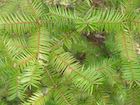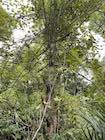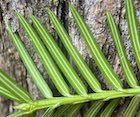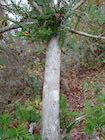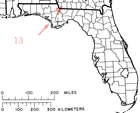Torreya taxifolia
Arnott 1838
Common names
Florida nutmeg tree, stinking cedar, gopherwood (Hils 1993).
Taxonomic notes
Type species of the genus Torreya. Syn: Tumion taxifolium (Arnott) Greene (Hils 1993). The type locality is on the Appalachicola River between Flint and Chattahoochie (Arnott 1838).
Description
Dioecious evergreen trees to 18 m tall and 80 cm dbh, usually much smaller, with an open broad-conical crown of ascending, spreading branches. Bark smooth, roughened or sometimes flaky, developing irregular longitudinal fissures, pale brown, aging to dark gray. Twigs slender, round, usually with opposite branching, sometimes with more than two laterals from a node, spreading horizontally at 40-60° from the main twig, green turning yellowish brown after a year, grooved along decurrent leaf bases. Buds terminal and very small, or at previous year's node and enlarged, broad-triangular, keeled, brown, deciduous. Leaves pectinate, spreading at 50-80° from the shoot, linear, 15-38 × 2-3.2 mm, straight or slightly downturned, with a twisted short petiole, abruptly wider at base, apex cuspidate, coriaceous, lustrous green above, with two pale gray stomatal bands on lower surface, 0.4 mm wide, separated by a 0.6-0.8 mm wide midrib and bordered by 0.6-0.8 mm wide flat or very narrowly revolute margins; stomata randomly distributed within the band. Pollen cones axillary, solitary, in short rows below lateral twigs, 5-6 × 4.5-5 mm, pale yellow at maturity. Seeds borne in axillary structures, paired, sessile, the ripe aril smooth, dark green streaked with purple, obovoid or broad-ellipsoid, 25-35 × 25 mm (Farjon 2010). See García Esteban et al. (2004) for a detailed characterization of the wood anatomy.
Distribution and Ecology
USA: Georgia, Florida at 15-30 m elevation on river bluffs, slopes, and moist ravines along a 33-km stretch of the Appalachicola River (Godfrey and Kurz 1962, Hils 1993). The tree is much more common in cultivation, and is widely planted outside of its native range, both as an ornamental and, more recently, as part of a coordinated effort to conserve the species; see the Torreya Guardians web site for further details. Since these ex situ conservation efforts are intended to facilitate naturalization of the species to facilitate recovery from disease and adaptation to climate change, it is expected that the distribution will change over time. Currently ex situ plantings occur from Georgia to Wisconsin and New Hampshire and an assisted migration program is in development (Torreya Guardians, accessed 2022.12.19)
The species is a rare endemic. Populations were thriving until the 1950s, but since then they have been decimated by fungal disease (Godfrey and Kurz 1962, Lee et. al. 1995). For many years the fungal agent defied all efforts at identification, until finally Smith et al. (2011), using gene sequencing techniques on samples collected from infected trees, showed it to be the previously-undescribed species Fusarium torreyae. Field surveys throughout its native range in 2009 revealed that all dead and the vast majority of living T. taxifolia trees showed signs of canker disease (Aoki et al. 2013).
By 1962, only nonreproductive stump sprouts remained in the wild. In 1984, the Florida torreya was listed as endangered under the US Endangered Species Act. A recovery plan was approved in 1996, and efforts are underway to reestablish this once thriving species in its native habitat. Currently, the continued survival of the species apparently depends entirely on plants in cultivation (McMahan 1989, Hils 1993, American Forests 1996). In 2010 the U.S. Fish and Wildlife Service produced a Review describing progress to date in conserving the species, and concluding "Despite the conservation actions to protect and determine the cause of this species’ decline, the degree of threat to its persistence remains high; therefore the threat of extinction that faces T. taxifolia is imminent."
Zone 9 (cold hardiness limit between -6.6°C and -1.1°C) (Bannister and Neuner 2001), although Frank Callahan (email 2016.09.25) asserts that trees at the Biltmore estate in North Carolina have survived temperatures as low as -31°C.
The ravines inhabited by Florida torreya and its cousin, the rare yew Taxus floridana, are a rather unusual geomorphic feature; an example can be seen HERE.
Remarkable Specimens
A tree in a yard in Norlina, North Carolina, is 16.1 m tall and 100 cm dbh. This tree was planted ca. 1860, which also makes it the oldest documented tree in this species, and was received as a gift from President Buchanan. It was recognized as one of the largest Florida torreyas as early as the 1950s and has generally remained healthy and grown substantially larger since that time. A very detailed documentation of this well-known tree is provided by Torreya Guardians. The same source identifies the second-largest specimen as a tree in Spring Grove Cemetery in Cincinnati, Ohio.
Ethnobotany
The species was formerly used for fuel, fence posts, and shingles (American Forests 1996), but now is limited to ornamental uses. It has seen use in dendrochronology. Schwarz and Hermann (1999) used subfossil wood samples to compare growth rates of T. californica and T. taxifolia, finding no significant differences. Atchley (2004) performed an interesting dendroclimatic study using subfossil wood, searching for evidence of a climate or similar change that may have contributed to the T. taxifolia decline; she found evidence of drought and higher temperatures, both related to timber harvest in the area, and concludes that these may have been factors in the species' decline.
Observations
It is still be possible to see the species in Torreya State Park, where only stump sprouts and saplings survive. To see a healthy tree, you must find it in an arboretum, ornamental planting, or ex situ conservation site.
Remarks
The epithet "taxifolia" means "leaves like Taxus" (yew). Other species in the genus have leaves considerably longer that those of most yews, although that is probably fortuitous, as the other species were described after this one was named.
This is one of only two native U.S. conifers protected under the Endangered Species Act (the other is Hesperocyparis abramsiana).
Citations
American Forests 1996. The 1996-1997 National Register of Big Trees. Washington, DC: American Forests.
Aoki, T., J. A. Smith, L. L. Mount, D. M. Geiser, and K. O'Donnell. 2013. Fusarium torreyae sp. nov., a pathogen causing canker disease of Florida torreya (Torreya taxifolia), a critically endangered conifer restricted to northern Florida and southwestern Georgia. Mycologia 105(2):312-319. doi: 10.3852/12-262.
Arnott, G. A. W. 1838. On the genus Torreya. Annals of Natural History 1:126-131 (P. 130).
Atchley, Elizabeth A. 2004. The effects of habitat alterations on growth and vitality of Torreya taxifolia Arn. in
northern Florida, U.S.A.: a dendroecological study. Master's Thesis, University of Tennessee.
https://trace.tennessee.edu/utk_gradthes/4660, accessed 2022.12.19.
Godfrey, R. L. and H. Kurz. 1962. The Florida torreya destined for extinction. Science 136: 900, 902.
Schwartz, M., and S. Hermann. 1999. Is slow growth of the Endangered Torreya taxifolia (Arn.) normal? Journal of the Torrey Botanical Society 126:307. doi:10.2307/2997314.
Smith, Jason A., Kerry O'Donnell, Lacey L. Mount, Keumchul Shin, Kelly Peacock, Aaron Trulock, Tova Spector, Jenny Cruse-Sanders, and Ron Determann. 2011. A novel Fusarium species causes a canker Ddsease of the critically endangered conifer, Torreya taxifolia. Plant Disease 95(6):633-639, https://doi.org/10.1094/PDIS-10-10-0703.
See also
Center for Plant Conservation, accessed 2009.03.29. Highly recommended!
Elwes and Henry 1906-1913 at the Biodiversity Heritage Library. This series of volumes, privately printed, provides some of the most engaging descriptions of conifers ever published. Although they only treat species cultivated in the U.K. and Ireland, and the taxonomy is a bit dated, still these accounts are thorough, treating such topics as species description, range, varieties, exceptionally old or tall specimens, remarkable trees, and cultivation. Despite being over a century old, they are generally accurate, and are illustrated with some remarkable photographs and lithographs.
Natureserve Explorer, accessed 2009.03.29.
Savage (1983).
Stalter and Dial (1984).
Stein, W.I. 2008. Torreya Arn. torreya. Pp. 1121-1124 in Woody Plant Seed Manual, USDA Forest Service, https://www.fs.usda.gov/nsl/Wpsm/Torreya.pdf, accessed 2022.12.19, provides useful information on propagation.
U.S. Fish and Wildlife Service (1986).
